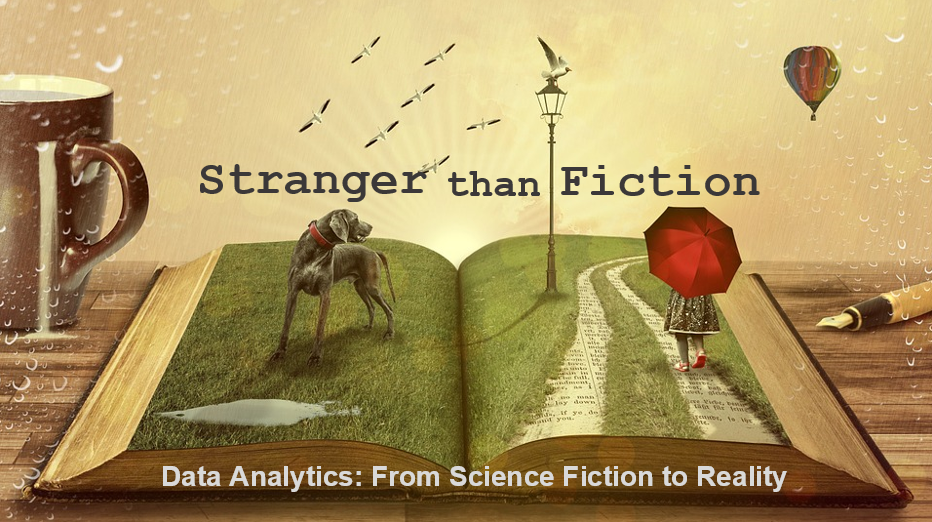
An increasingly popular trend in business intelligence is developing and fine-tuning data analytics tools to help anticipate even the most minute uptick in customer trends, needs, and desires. At SlashDB, we celebrate this trend because it raises awareness about data’s amazing abilities. Data analytics tools help construct predictive models that businesses use to pinpoint what their customers want – changing customer service into a proactive rather than a reactive element.
A Foundation Built on Science Fiction

Modern technologies and capabilities, including data analytics, formerly existed only in the annals of science fiction. Take for instance, Isaac Asimov’s invention of psychohistory, a branch of mathematical sociology in the Hugo-award winning Foundation series. The premise of the Foundation series revolves around the protagonist’s, Hari Seldon’s, theory of psychohistory, a concept he spends his professional career perfecting. Seldon’s psychohistory is able to predict large scale events, such as when one country will attack another country, but not small-scale events, such as when John Smith of Cleveland, Ohio will spill coffee on his keyboard.
In other words, psychohistory is about predicting the behavior of targeted groups of people through a carefully formulated model of group psychology. Most intriguing of all is the fact that the predictions are completely reliant on data – not esoteric technology left behind by aliens from another universe. Unknowingly, Asimov seems to have predicted the role of data analytics and Big Data as early as 1942 when he began publishing the interrelated short stories that make up the first novel in his famed series, Foundation, in Astounding Magazine.
Kindred Spirits: Psychohistory and Data Analytics

Seventy-five years have passed since Asimov first wrote about psychohistory and the core requirements for his imagined science now closely align with the core requirements of data analytics. Both require:
- a large population of subjects / a large dataset
- detailed behavioral data on all of the subjects
- analytical technology that can organize huge amounts of data (much like SlashDB’s API)
When Asimov wrote about psychohistory, these requirements were unattainable and belonged firmly in the realm of science fiction. However, with the world population now higher than ever (more than meeting the requisite of a large dataset) and with the onset of technological innovation – psychohistory has become fact rather than fiction, we just call by a different name – data analytics.

An interesting example of psychohistory (or in modern terms data analytics) is a study conducted by the University of Pennsylvania. The study found a remarkable correlation between the county-level frequency of heart disease and the emotional content of the county’s Twitter posts. The study compared a county map annotated with cases of heart disease with a county map of negative statements in Twitter posts. The research team then measured expected county heart health levels based on the number of negative statements about health, work, and body image, as well an increased usage of curse words in Twitter posts. Incredibly, this method proved to be a more efficient predictor of potential heart disease than the 10 standard predictors typically used (including level of education, obesity, and smoking). Astonishingly, Twitter beat the traditional predictor model by 36 – 42 %.
The Future Arrives: Big Data and APIs
While Asimov predicted Big Data in the form of psychohistory, he never anticipated the modern data analytics tools and APIs necessary to process massive amounts of data.
Combining data analytics tools with APIs such as SlashDB enables efficient and in-depth data collection. APIs help extract more specific data and expose real-time data for more precise and up-to-date predictions of behavior – and even heart health.
Combining data analytics tools with APIs can help businesses construct more detailed and consumer-specific predictive models and applications. These predictive models and apps help businesses to fully gauge the desires and needs of their customers – enabling proactive customer support and, in turn, higher customer satisfaction.
SlashDB: Your Bridge from Science Fiction to Reality
Adding an API add-on like SlashDB to your data analytics set-up can help you extract important data from predictive models, enabling you to meet and exceed customer expectations across multiple channels. Our technology will help bring you into the future of data analytics and give you the impressive predictive powers that Asimov only conceived of as science fiction.

Important Reasons Why You Should Pair SlashDB with Your Data Analytics Tools
- SlashDB makes databases easily accessible from any analysis tool including (but not limited to): R Studio, Jupyter Notebook, QlikView, Tableau, and Excel.
- SlashDB makes working with databases as simple as working with plain files – with the added bonus that the data retains its integrity and authorizations while staying up-to-date.
- SlashDB allows users to access and retrieve data with ease, relying on their intuition to extract the data they need rather than relying on complicated search queries.
- With SlashDB, the content in your data analysis software or database becomes accessible through authorized web and mobile applications.
 SlashDB has made it our mission to make data retrieval a highly accessible, searchable, and intuitive process. Unlike data extracts, SlashDB API is an automated, live link to your business’ databases, allowing for faster and up-to-date access to data, so you can make eerily accurate predictions about the needs and desires of your consumers.
SlashDB has made it our mission to make data retrieval a highly accessible, searchable, and intuitive process. Unlike data extracts, SlashDB API is an automated, live link to your business’ databases, allowing for faster and up-to-date access to data, so you can make eerily accurate predictions about the needs and desires of your consumers.
Contact us and we’ll work with you to find the best API add-on configuration for your business needs.
